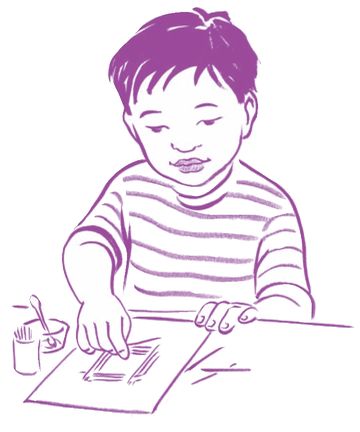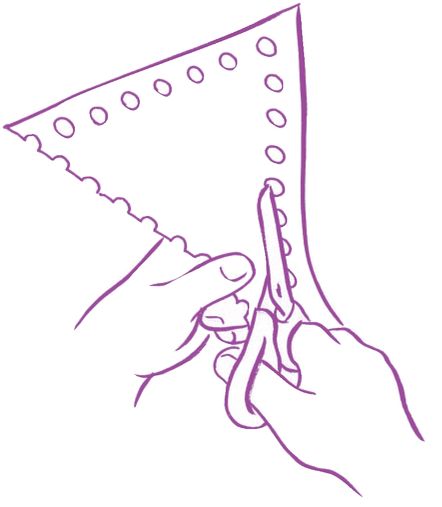Everyday Play (6 page)
Authors: Christy Isbell

Develops your child’s finger coordination
What You Needchild-size gloves (small women’s gloves may also work) | scissors (adult-use only) | school glue or fabric glue in small bowls and cotton swabs (school glue will require more drying time) | markers | sequins, small buttons, small pompoms, and plastic eyes
What to Do• Cut the fingers out of the gloves (adult-only step).
• Give your child at least two finger puppets to decorate with markers, sequins, buttons, small pom-poms, and plastic eyes.
• After the glue dries, invite him to use his finger puppets to put on a show.
• Encourage him to use puppets on both hands in his finger puppet show.

• Ask him to act out a favorite story, book, or song with his finger puppets.
Gives your child practice with putting together simple puzzles and using various tools in play
What You Needdigital camera | printer | thick paper, such as card stock or oak tag | glue sticks | child-size scissors | resealable plastic bags to store puzzles after use
What to Do• Use the digital camera to take a close-up photograph of your child.
• Print the photograph on 5” x 7” or 8” x 10” photo paper.
• Give your child a piece of card stock to fit her photograph (5” x 7” or 8” x 10”), and have her glue the photograph to the card stock. Allow it to dry completely.
• Show her how to cut the attached photographs into six or eight irregularly shaped puzzle pieces, and help her, as needed.
• Encourage her to take apart and put together her own puzzle.
• If a camera and printer are not available, use magazine photos instead.
• Make puzzles out of photographs of her favorite people or pets.
Refines your child’s grasp and release and builds
hand strength
What You Needhand strength
sugar cookies | cake icing | edible sprinkles | tubes of decorating icing (squeeze type) | plastic knives and spoons
What to Do• Encourage your child to spread icing onto cookies using knives or spoons.
• Encourage him to use his fingers to place sprinkles—one pinch at a time—on his cookies. Eat and enjoy!
• Offer toothpicks for him to draw designs in the icing.
Develops your child’s grasp and pre-scissor skills
What You Needmedicine droppers | food coloring | water | small bowl(s) | coffee filters (basket-style work best)
What to Do• Mix food coloring with water in a bowl. You may prefer to use several colors in different bowls for this activity.
• Show your child how to fill the medicine dropper with colored water. Then, show her how to squeeze the medicine dropper to make “drops of color” on the coffee filter.
• Let her create her own “drops of color” on the filters.
• The “drops of color” art makes a very interesting sun catcher. Help your child punch a hole in the top of the filter and tie on a piece of string. Hang the art in front of a window. Laminate if desired
.
.
Improves your child’s grasp and release of small objects
What You Needreusable stickers, such as Colorforms, Unisets, or window stickers | small dry-erase board or unbreakable hand-held mirror | easel or incline board (see Incline Writing Boards activity on page 71 for instructions)
What to Do• Place a dry-erase board or mirror on an easel or incline board.
• Encourage your child to use stickers to decorate the board or tell a story.
• When the play is over, ask him to remove stickers and replace them into storage.
• Provide dry-erase markers for your child to trace around re-usable stickers.
• If possible, let him decorate a nearby window with stickers.
Helps your child develop her pincer grasp
What You Needvariety of seeds, such as pumpkin, sunflower, or apple | glue | small bowls or nut cups | cotton swabs | construction paper | large markers | shape templates
What to Do• Encourage your child to draw shapes on her construction paper. Alternately, she may use templates to trace shapes.
Note:
Do not cut out the shapes.
Do not cut out the shapes.
• Pour glue into small bowls, provide cotton swabs for dipping, and pour seeds into small bowls or nut cups (adult-only step). Use a separate bowl for each type of seed.
• Show your child how to use the cotton swabs to dab glue onto her shapes, and invite her to place seeds onto the glued area, remaining inside the traced area.
• Hang the work once it dries.

Gives your child practice with his pincer grasp and
develops bilateral coordination
What You Needdevelops bilateral coordination
toothpicks | glue in small container for dipping | cotton swabs | thick paper, such as index cards, oak tag, or poster board
What to Do• Give your child a piece of thick paper to use as the “foundation” for his construction.
• Demonstrate how to dip toothpicks into glue or use cotton swabs to place glue on a structure to hold it in place.
• Encourage him to build houses with toothpicks.
• Read or tell the story of the “Three Little Pigs,” and then encourage your child to try building with pieces of straw or craft sticks.

Develops your child’s grasp strength
What You Needmasking tape | clear tape | variety of paper | child-safe scissors | paper towel rolls
What to Do• Place the different tapes and variety of papers on a table.
• Encourage your child to tape the paper to the paper towel roll to create original work.
• Show her how to tear the tape.
• Observe how she uses the materials for self-expression.
• Ask your child to describe her creation and transcribe her words, if she is interested. Display the description alongside her original work.
Improves your child’s hand strength
What You Needlarge plastic container | various “terrains,” including sand, potting soil, pebbles, pea gravel, and mulch | variety of very small toy trucks or construction vehicles
What to Do• Prepare one “terrain” on each part of the container (For example, put sand at one end of the table and potting soil on the other end).
• Invite your child to drive his “All Terrain Vehicles” through/over the terrain.
• Ask him to build hills or mountains out of the material laid out on the table.
• Suggest that he drive his vehicles “over,” “around,” and “through” the hills. Demonstrate these directions, as needed.
• Ask your child to use his vehicles to make different track shapes in the terrain.

Develops your child’s grasp and improves finger strength
What You Needgreen playdough | plastic bowl and spoon
What to Do• Demonstrate how to use your thumb, index, and middle fingers to create “peas” by rolling playdough into small balls.
• Remind your child that the “peas” are pretend and are not for eating.
• Encourage her to make tiny “peas” out of the playdough.
• Once your child masters the rolling motion, challenge her to use the spoon to fill a bowl with “peas.”
• Add plastic forks to the activity. See if your child can catch the “peas” on her fork.
• Encourage your child to use her index fingers to “smoosh” the peas.
Gives your child experience using scissors and improves his eye-hand coordination
What You Needpolka-dot shapes (see Polka-Dot Shapes activity on page 84) | child-safe scissors
What to Do• Do the Polka-Dot Shapes activity on page 84 . After this, your child will have a sheet of paper with holes forming a shape (circle, square, triangle).
• Show him how to use scissors to cut out the shape by cutting through the centers of the punched holes. The cut-out shapes will have scalloped edges when he finishes cutting through the holes along the edges.
• Encourage him to stay on the polka dots as he cuts out the shapes.
• Invite him to feel and explore the edges of these new shapes.
• If your child isn’t developmentally ready to cut out more elaborate shapes, use the hole punch to form simple lines (horizontal, vertical, or diagonal) for him to cut.

Other books
The Splintered Eye (The War of Memory Cycle) by H. Anthe Davis
The Indestructibles by Phillion, Matthew
The Fell Sword by Cameron, Miles
Changing Patterns by Judith Barrow
The Tin Drum by Gunter Grass, Breon Mitchell
Long Hot Summoning by Tanya Huff
The Things I Do For You by Mary Carter
Mortal Arts (A Lady Darby Mystery) by Huber, AnnaLee
Out of Africa: And Shadows on the Grass by Isak Dinesen
